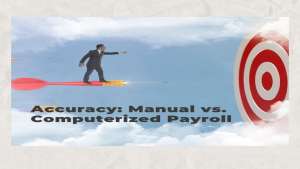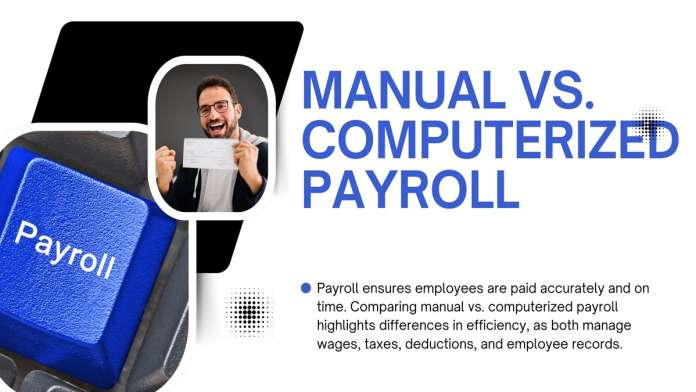Payroll is a crucial function of any business, ensuring employees are paid accurately and on time. When comparing manual vs. computerized payroll, these systems handle all the processes involved in compensating employees, including calculating wages, withholding taxes, and managing deductions. Both manual and computerized payroll systems keep records of hours worked, track employee benefits, and generate essential financial reports, though their methods and efficiencies differ significantly.
Understanding Payroll Systems: Manual vs. Computerized
There are two main types of payroll systems: manual and computerized. A manual payroll system is just as it sounds; it requires human effort to calculate and process each payroll period. This can involve physical paperwork, spreadsheets, and a considerable amount of time dedicated to computations. These manual processes can be cumbersome and prone to human error.
On the other hand, a computerized payroll automation most of the payroll tasks. Software solutions streamline calculations, tax withholdings, and financial reporting, reducing the likelihood of mistakes. These platforms can integrate with other business systems, such as time tracking and accounting software, for added efficiency.
Choosing the right payroll system for your business depends on various factors, such as the size of your workforce, your budget, and your need for accuracy. As technology evolves, computerized payroll systems are becoming increasingly popular due to their efficiency and reliability. Nevertheless, understanding the differences between these systems can help you make an informed decision that best suits your business requirements.
For many small businesses, the transition from manual to computerized payroll can mark a significant improvement in operations, leading to cost savings and better compliance with tax regulations.
Accuracy: Manual vs. Computerized Payroll

Accuracy is crucial in payroll management as even minor errors can lead to employee dissatisfaction, tax issues, and legal complications. Manual payroll systems are often prone to human error. Calculations done by hand or with spreadsheets can easily go awry, especially when dealing with overtime, deductions, and benefits. A simple mistake can result in significant discrepancies, and finding and correcting these errors can be time-consuming.
-
Improved Accuracy Through Automation
In contrast, computerized payroll systems dramatically improve accuracy by automating complex calculations. Once you input the initial data, the software handles everything from tax withholdings to benefits, reducing the risk of errors. Modern payroll software often comes with built-in compliance checks and updates, ensuring adherence to ever-changing federal and state regulations.
-
Streamlined Validation and Record-Keeping
Moreover, computerized systems simplify the validation process. Employers can easily generate reports to review calculations and ensure everything is correct before issuing payments. These systems also store historical payroll data, making it simple to audit past records and rectify any mistakes swiftly.
-
Impact of Accuracy on Compliance and Employee Trust
In essence, while manual payroll systems leave room for human error and demand meticulous attention to detail, computerized payroll systems offer a higher level of accuracy, relieving business owners and HR departments of a significant administrative burden. This accuracy not only ensures employees are paid correctly and on time but also keeps your business compliant with tax laws and regulations.
By prioritizing accuracy through a computerized payroll system, businesses can maintain employee trust, avoid costly errors, and streamline their entire payroll process.
-
Cost Considerations in Payroll Management
When it comes to managing payroll, the cost is a significant factor business owners need to consider. Comparing manual and computerized payroll systems reveals distinct differences in expense that can impact your bottom line.
Time Savings and Efficiency in Payroll Processing

-
Initial Cost Considerations
Manual payroll systems might seem economical at first glance. There’s no need for software purchases or recurring subscription fees. However, the hidden costs can be substantial. Calculating each employee’s wages, deductions, and taxes by hand is labor-intensive. This increases the demand for administrative staff, elevating labor costs. Additionally, the likelihood of human error is higher, which could lead to costly mistakes and penalties from tax authorities.
-
Efficiency and Labor Costs
On the flip side, computerized payroll systems typically come with upfront costs for software purchase or ongoing fees for cloud-based services. However, these systems automate much of the payroll process, significantly reducing the amount of time required. This efficiency translates to lower labor costs since fewer staff hours are needed for payroll tasks. Moreover, automated systems often include compliance updates, helping businesses avoid penalties and associated costs.
-
Scalability and Complexity
Another point to consider is scalability. As your business grows, the manual process becomes increasingly complex and time-consuming, potentially necessitating additional staffing. A computerized system scales more seamlessly, handling increased data without proportionate increases in labor costs.
-
Long-Term Savings
While manual systems might appear cheaper initially, the long-term savings and efficiencies offered by computerized payroll systems make them a wise investment for most businesses. This comprehensive understanding of cost comparison can guide you to choose the best payroll solution to suit your company’s needs and growth.
The Advantages of Computerized Payroll Systems Over Manual Processes

In today’s fast-paced business environment, efficiency and time savings are crucial when managing payroll. When comparing manual and computerized payroll systems, the differences are stark.
-
Challenges of Manual Payroll Processes
Manual payroll processes involve a significant amount of paperwork and manual calculations. This not only increases the risk of human error but also consumes a considerable amount of time. Every payroll cycle, HR personnel must tally hours, calculate deductions, and ensure compliance with tax laws. These tasks can take hours to days, especially for larger businesses, leading to inefficiencies and potential delays in employee payments.
-
Streamlined Processes
On the other hand, computerized payroll systems streamline these tasks, transforming hours of work into just a few clicks. Sophisticated software automates calculations, tax deductions, and compliance checks. This automation means payroll can be processed in a fraction of the time it takes with a manual system. For growing businesses, the ability to scale operations without a proportional increase in HR workload is invaluable.
-
Integration with Other Tools
Furthermore, modern computerized payroll systems often integrate with time-tracking software and financial management tools, providing a seamless end-to-end solution for payroll management. Reports can be generated instantly, offering insights and aiding in strategic decision-making.
In conclusion, the time savings and efficiency gains from using a computerized payroll system are substantial. They free up valuable HR resources, reduce the risk of errors, and ensure timely, accurate payroll processing. For most businesses, the transition to a computerized system is not just a convenience—it’s a necessity for maintaining competitiveness in the modern market.
Security Concerns and Data Integrity

In today’s digital world, the security of your payroll system is paramount. When comparing manual and computerized payroll systems, it’s clear that each presents distinct security challenges and benefits.
-
Security Risks in Manual Payroll Systems
Manual payroll systems rely heavily on physical documents and human oversight. While this method can sometimes create a sense of control, it also introduces significant risks. Paper records are vulnerable to theft, loss, and unauthorized access. Additionally, manual handling increases the likelihood of human errors, which can compromise data integrity and result in payroll discrepancies.
-
Benefits of Computerized Payroll Security
On the other hand, computerized payroll systems offer robust security features designed to protect sensitive employee information. Advanced encryption methods ensure that data is secure both in transit and at rest. Additionally, computerized systems often come with multi-factor authentication and role-based access controls, further safeguarding against unauthorized access. These layers of security help maintain the integrity of payroll data and prevent fraud.
- Data Backup and Recovery in Payroll Systems: Another key advantage of computerized payroll systems is the automatic creation of backup copies. In the event of a system failure or data breach, having secure backups ensures that data can be quickly restored, minimizing downtime and financial loss.
- Cybersecurity Best Practices for Payroll Systems: However, it’s important to remember that computerized systems are not entirely immune to cyber threats. Regular software updates, strong password policies, and continuous monitoring are essential to maintaining a secure payroll environment.
In conclusion, while manual payroll systems can feel more tangible and controlled, computerized payroll systems offer superior security features and data integrity measures. By investing in a robust computerized system, businesses can better protect sensitive payroll information and ensure accurate, reliable operations.
Conclusion: Choosing the Right Payroll System for Your Business

Selecting the right payroll system for your business is a crucial decision that can significantly impact your company’s operations, efficiency, and compliance. Both manual and computerized payroll systems have their pros and cons, and understanding these can help you make an informed choice.
-
Manual Payroll: Control vs. Limitations
Manual payroll systems offer a more hands-on approach, giving small businesses greater control over payroll processes. They are generally cheaper upfront and require minimal technological investment. However, the manual processing can be time-consuming and prone to human errors, which can lead to inaccuracies in employee paychecks and tax filings.
-
Computerized Payroll: Efficiency and Reliability
On the other hand, computerized payroll systems provide a more streamlined and efficient solution. They automate calculations, reduce errors, and can easily handle complex payroll scenarios. These systems often come with features that ensure compliance with various tax regulations and labor laws, thereby reducing the risk of costly mistakes. While the initial setup and ongoing maintenance costs can be higher, the time savings and improved accuracy can offer substantial long-term benefits.
-
Data Security:
Another important consideration is data security. Manual systems are susceptible to physical risks like fire or theft, whereas computerized systems often include robust security measures, such as encryption and back-up protocols, to protect sensitive employee data.
Ultimately, the best payroll system for your business will depend on your specific needs, size, and budget. Consider the scale of your operations, the complexity of your payroll needs, and the resources you are willing to invest. By carefully weighing these factors, you can choose a payroll system that enhances your business’s efficiency and reliability.
Read More: Top 10 Popular SaaS Marketing Blogs in 2024

